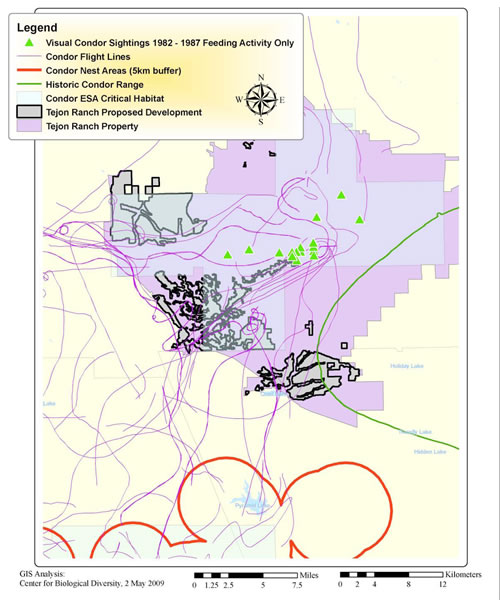
The Kern County Planning Commission has approved development plans for an exclusive gated community featuring luxury homes, golf courses, and hotels in the middle of designated California condor habitat.
Thanks to an elaborate marketing and PR campaign by Tejon Ranch Company (TRC), a massive development project in the heart of California condor habitat has been given the green light by the Kern County Planning Commission.
‘Tejon Preserve’ – a PR smokescreen?
It appears that Tejon Preserve is essentially TRC’s mandatory “Habitat Conservation Plan.”
TRC was required to create a Habitat Conservation Plan in order to receive an “Incidental Take” permit from the U.S. Fish and Wildlife Service (USFWS).
“Take” is defined in the Endangered Species Act (ESA) as harass, harm, pursue, hunt, shoot, wound, kill, trap, capture, or collect any threatened or endangered species. Harm may include significant habitat modification where it actually kills or injures a listed species through impairment of essential behavior (e.g., nesting or reproduction).
TRC knew from the beginning that if the public found out their development project was going to harm California condors, it would have a difficult time moving forward.
So Tejon Ranch Company developed an elaborate smokescreen and called it “Tejon Preserve.”
And, in order to keep the “incidental take” issue quiet while they concocted their “Habitat Conservation Plan”, TRC filed a protective order with its own lawsuit.
Then, last month, in a clever PR move, TRC announced the lifting of the protective order.
Tejon Ranch Company is asking the U.S. Fish and Wildlife Service (FWS) and the Department of Justice to support its efforts to have a U.S. District Court vacate a Protective Order issued to maintain the confidential nature of settlement negotiations between the Tejon Ranch and the FWS over a federal lawsuit filed by the Ranch in 1997.
As a result of the settlement, for the past ten years Tejon Ranch has been working with FWS toward completion of an HCP. As is common in litigation, settlement discussions between the parties – in this case Tejon Ranch and FWS – were confidential. A Protective Order, mutually agreed to by Tejon Ranch and the FWS, that established the scope of this confidentiality arrangement for settlement discussions, was issued by the court in 2002.
Tejon Ranch Company already has an unfortunate history when it comes to the California condor: Tejon Ranch Company was also involved in the killing of one of the last wild-born California condors.
In Feb. 2003, one of the last wild-born condors was shot and killed during a hunting event sponsored by the Tejon Ranch Company. The death of AC-8 was a terrible tragedy, since she was the second-to-last condor taken from the wild. Condor AC-8 played an important role in the recovery effort, hatching numerous chicks and providing critical guidance and wisdom to young captive-reared condors that are now in the wild. She was one of only nine condors with experience living in the wild, and her return to the wild was considered one of the great successes of the recovery program.
The hunter who shot AC-8 was nominally fined. The Center for Biological Diversity requested that the USFWS and the California attorney general investigate the role of Tejon Ranch Company in the killing, but no action was taken.
Tejon Ranch Company makes a deal with environmentalists
So where are the environmentalists and why aren’t they opposed to the development of Tejon Mountain Village?
Several large environmental organizations – called “Resource Groups” – have agreed to support the Tejon Mountain Village Project under the “Tejon Ranch Conservation and Land Use Agreement.”
Look closely – this deal means that in exchange for use of “some” of the land, “Resource Groups” agree not to oppose Tejon Mountain Viilage – or the other development projects planned by TRC.
Opposition. The Resource Groups will refrain from opposing the entitlement and permit
applications and approvals for the three development projects.
Who are the “Resource Groups”?
- The Sierra Club
- Natural Resources Defense Council
- Audubon California
- Planning and Conservation League
- Endangered Habitats League
Fortunately, not all environmental groups have … sold out, er, signed on: The Center for Biological Diversity is one of the environmental organizations acting in opposition to the development of Tejon Mountain Village.
Adam Keats, an attorney with the Center for Biological Diversity, questions the ethics and legality of Tejon Mountain Village.
It’s building houses in the middle of prime foraging habitat, and it’s replacing natural feed of a species with a handout. It’s not natural, it’s not ethical, it’s not legal.
Location of TRC’s development project in relation to condor feeding, nesting areas
Dr. Christopher Cogan’s study “California Condor Activity in the Tejon Ranch Region” reveals that TRC’s development is planned in an area which connects the condors’ feeding area with nesting grounds.

Note how the flight lines that pass over the proposed development areas identify critical habitat which acts to connect the feeding areas with nesting areas. This figure highlights multiple activities (nesting, flying, and feeding) within the California montane chaparral and woodland ecoregion. This figure also suggests how impacts in the Tejon area could also impact (for example) nesting areas 40 km to the south.
Dr. Cogan also cited the following statement from an earlier research report regarding the sensitivity of nesting condors to human activity:
One man can keep a pair of condors from the egg all night or prevent the feeding of a chick for an entire day merely by exposing himself within 500 yards of a nest for a few minutes at one or two critical times of the day. Loud noises can alarm condors at distances of over one mile. Individuals or groups of persons moving about must keep at least one-half mile from condor nests in order to void disturbance of the parent birds.
Thus, Tejon Ranch Company’s planned development will significantly disrupt – and possibly prevent – the feeding, nesting, and chick-rearing activities of critically endangered
California condors.
It’s called “incidental take.”
Approval process not over yet
Despite winning approval from the Kern County Planning Commission, there’s another issue: That “incidental take” permit.
According the Center’s attorney Keats, the USFWS has not approved the “incidental take” permit.
Let’s hope that permit does not get approved.
California Condor population
There are only 358 California Condors left in the world. 169 are in captivity, and 189 are flying free.
You can visit Save Tejon Ranch for additional California Condor information.
Map image: Cogan, Christopher B. 2009. California Condor Activity in the Tejon Ranch Region. Center for Biological Diversity Report, 12 June 2009. San Francisco, CA, USA. 22pp.
Thanks to the Center for Biological Diversity for including this article in New Archives.
